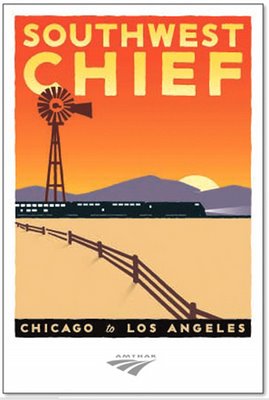Leave flying behind

I have never liked flying, and every year my 800 mile (each way) trip just gets worse. Denying me water on airplanes that are already deficient in decent air and food and restroom facilities (3 for 175 passengers + crew!) was the final straw. That leaves bus, train, and automobile as my remaining choices.
Buses share much of what I dislike about planes: cramped, surrounded by strangers, poor restroom facilities, and general prolonged discomfort.
Automobile is a reasonable option, with my fuel-efficient, reliable and comfortable car. But that’s a lot of driving, with a one-night motel stay each direction, providing poor sleep and costing more money.
The train will take about 1 day (and night) of travel each way, while any plane trip has always taken up the better part of a day, once you factor in security and baggage and check-in issues. The car mode takes two days of travel. But on the train, travel time can be spent sleeping, eating decent food, breathing plentiful air, staring out the window, watching movies on the laptop, writing, talking on the phone, taking pictures, reading, walking, having random conversations, and always having the option of solitude in your little room, or even, of brushing your teeth and drinking some water.
Cost considerations:
The bus is by far the cheapest (with good reason): [$142 (with early booking) + ($50 for shuttles)] = $192
The train (coach seating) is competitive with the bus, at [$212 (+$50 for shuttles)] = $262
Flying is the next cheapest (with early booking) at [$292 (+ $50 for shuttles)] = $342
Driving has the up-front costs of [(46 gallons x $3.10 = $142.60) + ($90 lodging x 2 = $180) + ($100 for 10 meals)] = $423, but that doesn’t account for wear and tear or any potential break-downs.
My choice? The train, with sleeper compartment: $662 + ($50 for shuttles) = $712, but this choice also includes 5 meals, free bottled water, wine and cheese, a private compartment, and a bed for two nights. (Cost-per-passenger would go down if two shared the compartment.)
The car would be (by far) the most dangerous mode, and although there have been too many train wrecks recently, one’s odds of surviving a train wreck are far greater than surviving a plane wreck.
What about the environmental factors? This is where the train really excels. According to the US Department of Transportation, Bureau of Transportation Statistics, the “energy intensity” of these varied modes of transportation (measured in Btu per passenger mile) are (1998 figures):
Air (domestic): 4123 Btu
(This probably assumes that the plane is nearly filled with passengers, so if this is not the case, consumption would go up accordingly.)
Car: 3672 Btu
(However, this is for “average occupancy,” probably about 2 people/car, and a single person per car would increase energy consumption per mile by factor of 2.)
Bus: 3729 Btu
Train (Amtrak): 2138 Btu
(However, this is probably a fleet-wide calculation, and those occupying compartments would account for more energy consumption per mile, while those in Coach would account for less.)
Regardless of other pollution, Btu’s consumed are directly correlated with the emissions of CO2 (since carbon out must equal carbon in), so trains clearly have less impact than planes on global warming.
There are a lot of good reasons for choosing the train, with travel time being the only count against it, but if you want to see the country you’re traveling through, nothing compares in terms of safety and comfort. I know that I’ll be remembering last year’s airport and flying nightmare while I am enjoying my “land cruise,” sipping water with my feet up, settling in for a nap, wandering down to the dining car, or partaking of the wine and cheese offering.
Life is about journeys, not destinations.




0 Comments:
Post a Comment
<< Home